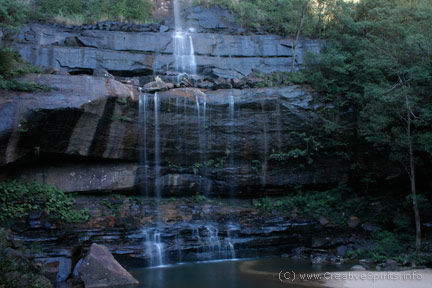History
Timeline results for
Found 1169 results for your search. Showing page 57 of 59.
10,000
-
Aboriginal people at Wyrie Swamp near Millicent, 340 kms south-east of Adelaide, South Australia, use returning boomerangs to hunt waterfowl.
120,000
-
Analysis of pollen and charcoal giving a date of 120,000 BP suggests that people were using fire to clear land in the Lake George basin in the Southern Tablelands of NSW, about 30 kms north-east of Canberra. [1] Experts also found signs of human disturbance in rainforest pollen patterns in a drill core from the edge of the continental shelf, 80 kilometres east of Cairns.
Similarly, research presented to the Royal Society of Victoria in 2019 by a group of academics found that blackened stones at Moyjil (Point Ritchie, Victoria), were between 100,000 and 130,000 years old. While cautious, the authors concluded that human habitation was the most likely explanation for "marine shells, stones in unexplained depositional context and fire resemblance to hearth". [2]
125
-
Archaeologists in 2020 found ancient banana farms on Mabuyag Island, once managed by Torres Strait Islanders, dating back 2,145 years. They unearthed banana microfossils, stone tools, charcoal and a series of retaining walls. The findings strengthen the theory that the Islanders engaged in complex and diverse cultivation and horticultural practices. [3]
13,000
-
Land bridges between mainland Australia and Tasmania are flooded. Tasmanian Aboriginal people become isolated for the next 12,000 - 13,000 years.
-
At Kow Swamp near Cohuna, 230 kms north of Melbourne, Victoria, Aboriginal people weare kangaroo teeth headbands similar to those worn by men and women in the Central Desert in the 19th century.
16,000
-
Hearths, stone and bone tools, Shaws Creek near Yarramundi (60 kms north-west from Sydney), NSW.
-
Sea levels begin to rise as ice caps melt. Inland lakes such as Lake Mungo have dried up.
17,300
-
Scientists confirmed that a painting of a kangaroo in a sandstone rock shelter near the Drysdale River, in Western Australia’s remote Kimberley region, is about 17,300 years old, making it the oldest known rock art in Australia.
18,000
-
Harvesting grass seeds is integral to Aboriginal socio-economic life on the large grasslands. The seeds were ground and baked or roasted and eaten whole.
-
Art at Ubirr in Kakadu National Park (Northern Territory, 300 kms east of Darwin) depicts now extinct animals, the Thylacine (Tasmanian tiger), and Zaglossus (the long-beaked echidna).
20,000
-
Aboriginal people were dispersed across the entire continent, occupying places as remote as rock shelters on the Franklin River in south-west Tasmania and at Birrigai in the ranges of the Australian Capital Territory, which surrounds Canberra, the national capital.
-
Some 10% of Tasmania is covered by glacial ice. Kutikina Cave on the Franklin River is occupied by Tasmanian Aboriginal people at the height of the last ice age.
-
Rising seas partially submerge Sahul, the landmass that connects Australia, New Guinea and Tasmania, creating separate islands for each.
22,000
-
In deep caves under the Nullarbor Plains at Koonalda (at the western edge of South Australia, about 50 kms from the ocean), Aboriginal people mine flint and leave grooved designs on the cave walls. This is early evidence of the close relationship of art and work in Aboriginal life.
-
Aboriginal people living at Malangangarr in Arnhem Land, Northern Territory, use ground-edge grooved axes. Australian technology leads the world.
-
Age of a rock-shelter on the Kings Tableland near Wentworth Falls, NSW.

Wentworth Falls, New South Wales. An occupation site has been found in this area dated 22,000 years old.
26,000
-
Age of bones found in sediment at the Willandra Lakes Region of far western NSW.
-
The body of a woman from Lake Mungo provides the earliest evidence in the world of ritual cremation. The body is prepared with ochre before cremation.
28,000
-
Age of a charcoal drawing found at Narwala Gabarnmung, in the Northern Territory, assumed to be Australia’s oldest known rock art specimen and one of the earliest examples of human art on the planet [4]. The art was only found in 2012. Because it was made with charcoal, radiocarbon dating could be used to determine its age with a higher degree of confidence.
30,000
-
Oldest evidence of bread making in the world at Cuddy Springs (ancient lake located between Marra Creek and Macquarie River, near Carinda, western NSW).
References
View article sources (4)
[1]
'A history and interpretation of fire frequency in dry eucalypt forests and woodlands of Eastern Tasmania', J. von Platen, PhD thesis, University of Tasmania, 2008 p.15, http://eprints.utas.edu.au/7812/
[2]
''A big jump': People might have lived in Australia twice as long as we thought', The Guardian 11/3/2019
[3]
'Indigenous Australians 'farmed bananas 2,000 years ago'', BBC News 12/8/2020
[4]
'Kiwi finds 28,000 year old painting', The New Zealand Herald, 19/6/2012
